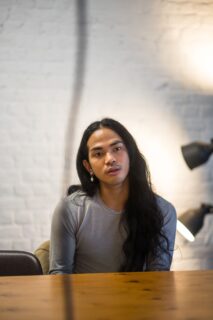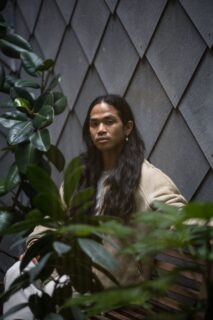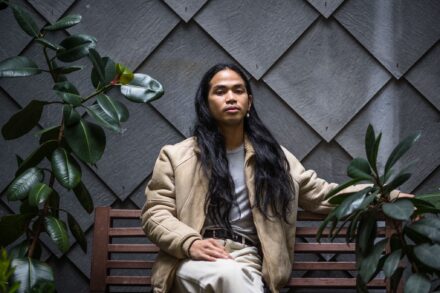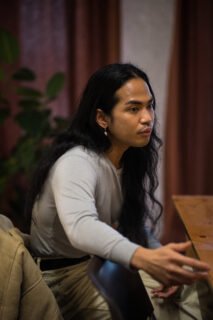Where did your idea for MISS come from?
Joshua Serafin: “I studied contemporary dance in Hong Kong for two years and was always interested in creating different identities in relation to my own cultural and historical background. I soon realised – when I started at P.A.RT.S. in Brussels to continue my dance education – that I was entering a Western school, with a Western ideology. I then asked myself how I could create something with a focus on my feelings and identity, both strongly rooted in the Philippines, and the fact that I am trying to express these feelings within a Western Institution.”
“Beauty queens are worth looking up to. That comes from the idea that they really deserve to be admired, unlike the politicians and governments who fail, year after year, to come up with solutions to the large-scale corruption in the country.”

Foto: Malkia Mutiri
“Already at the age of six, I was introduced to beauty pageants in my hometown. I was very fascinated by them. In the countryside, in the small village where I come from, small festivals called ‘fiestas’ take place regularly. These are small gatherings in the community, and there too I saw beauty queens all the time, taking part in these beauty pageants.”
“In a way they became superheroes for everyone. Filipinos listen to them more than to the president because they have so much prestige. This prestige mainly comes from the idea that if someone is able to bring such international glory to the country, they are worth looking up to.”
“Filipino beauty queens are in the global top ten every year in international beauty pageants such as Miss Universe. They truly deserve to be admired, according to many, unlike the politicians and governments who fail year after year to come up with solutions to the large-scale corruption in the country.”
“I took a lot of my historical cultural background with me in my research during the two years in Hong Kong and when I was studying at P.A.R.T.S. It has given me time and space to define the line of work that I want to develop. It started with the beauty pageants, but more and more it was about the global picture and narratives of queer identities.”
You talk about trans* identities: do beauty pageants in the Philippines follow a binary gender protocol?
Joshua Serafin: “No, absolutely not. There are so many variations, and it all comes from the fascination that surrounds it. Different groups of people make their own version of it.
When I was doing my research, I discovered that, for example, the Filipino diaspora in the 70s and 80s in New York who attended balls, in which mainly Black people and people with roots in Latin America participated, mostly stayed in the background as spectators. The ballroom scene emerged in the United States as a subculture for mainly LGBT+ people.”
“At those balls, ball queens walk down a catwalk in spectacular outfits, winning awards. It is a safe haven for a community that has all too often throughout history faced discrimination.
Anyway, Filipinos felt that it was not their place to play a forefront role. So they created their own beauty pageants, to create identities around the world and bring it to the communities themselves.”
In MISS, the body is central in a broader historical and personal context. What is the message of ‘the body’ and its movements?
Joshua Serafin: “First of all, my work changed a lot in time, because it evolved along with what I experienced on a personal level. Once I came back to Belgium, I was attacked several times in the streets because I embraced my queer identity – and sexuality. Those violent physical attacks influenced my work tremendously.
MISS is not just about beauty pageants, but also about raising awareness about the suffering and discrimination that I experience every day as a queer person, and at the same time as a person of colour. Being a minority in a western society takes much more work in many layers of that same society.”
“Being a minority in a western society takes much more work in many layers of that same society.”
“The piece is about the image that the body represents. And that image, of course, is not static. It is fluid, something that evolves and ‘becomes’. More specifically, this relates to, for example, the choice of not shaving my arm or leg hair, not wearing make-up, etc. Gender identity has nothing to do with what’s between your legs, it’s about the energy and ideology you feel and believe in, and how you communicate it to the environment you are navigating.”
“MISS shows an ideology that I choose to follow, away from binarity, making people aware of gender representations as social constructs that are assigned to us from birth.”
“The body I was given is central as a purely physical thing, but that form has nothing to do with what it represents. The piece is about ambiguity, about being non-binary. To be queer is to be in a constant flow where you navigate in between different identities, and extremities. In my performance I try to show possibilities, opportunities to ‘become’. MISS shows an ideology, away from binarity, making people aware of gender representations as social constructs that are assigned to us from birth.”
During your research, you discovered that traditional beauty pageants in the Philippines are strongly linked to religion and colonialism.
Joshua Serafin: “Yes, for that let’s go back to the very first beauty pageant in the Philippines, named Santacruzan, which takes place on the last day of the Catholic fiesta ‘Flores de Mayo’ (‘flowers of May’).”
“Santacruzan is, as a religious-historical beauty contest, the highlight of the Flores de Mayo festival. On that day, the Philippines honour the finding of the ‘True Cross’ by Saint Helena of Constantinople and her son Constantine the Great, the first Christian Roman emperor. Based on a European narrative, Spain brought it to the Philippines during the colonisation. Women then parade with a man and an escort, dressed in flowers.”

Foto: Malkia Mutiri
“Santacruzan is a competition, derived from a very religious, historical event: Constantine who conquers a certain place by possessing the cross. Spain always played with religion in the Philippines, where the majority of the population is still very Catholic to this day.”
“Later on, the Americans – who colonised the Philippines after the Spaniards – brought the tradition of carnival queens to Manila (capital of the Philippines). But imagine, the Philippines has more than 7,000 islands, and is thus an enormously difficult area to ‘conquer’. That’s why the US imperialists came up with the idea of sending one girl from each region to Manila. This way, beauty contests were used to get all the regions in one place and spread colonial ideologies.”
“US imperialists came up with the idea of sending one girl from each region to Manila, that way the beauty contests were used to spread colonial ideologies.”
“Of course, there is also an economic business model behind the pageants. The countries organising the contests count on visitors from different regions. The Philippines, Costa Rica and Venezuela are in strong competition with each other because the competitions in their countries attract the largest number of international visitors.”
“It is also a way for women to get out of poverty, there is a lot of hidden exploitation behind the pageants.”
“How far these girls go to fit in certain ideals to win, makes me feel alienated. The contests are also a way for women to get out of poverty, there is a lot of of hidden exploitation behind the pageants.”
What did you research in preparation for MISS?
Joshua Serafin: “For MISS, I did theoretical and practical research. I invited queer beauty queens to train me and show me how they move and ‘become’. Moreover, I am not only queer, I am also an immigrant body in Europe. Experiencing violence and turning it into care for the whole queer community, including women and every person of colour, is something I always strived for.”
“Growing up in a family with three sisters, I felt that as a young man I had to protect them from the violent outside world. This has highly shaped my personal ideologies, and contributed to what MISS eventually became.”
“By working with bodies and choreography, I access that trauma and try to physically express those felt pains, to decolonise them. Not only for myself and what I personally experienced, but especially for others. As an artist, I feel responsible for others who are going through similar pains and suffering.”
“Of course, I did have to make choices in that one-hour show. I experimented with how violence could be expressed through body language and choreography. The generational trauma in the body and in our muscles, and the history of our grandparents, is passed on from generation to generation, and it is our work to acknowledge these traumas, and to eventually be able to heal ourselves from it.
By working with ‘bodies’, I access that trauma and try to decolonise it and make those felt pains physical. I do this through dance, not only for myself and what I have personally experienced, but also for others. As an artist, I carry certain responsibilities in relation to other people who are going through similar pains and sufferings.”
You have played MISS in Bergen (Norway) and Ghent. Did you notice a difference between the audiences in the different countries and their reaction, depending on their history with colonialism?
Joshua Serafin: “There are differences between the two places, but also many similarities. For starters, in both cases the audience was predominantly white. So I’m curious what the audience will be in Beursschouwburg on Friday, because Brussels is more international compared to Bergen.”
“I felt ‘exotic’ there. Seeing a queer body of colour half-naked on a stage was not a familiar sight to the audience.”
“In Bergen I was at the top of Norway, you don’t see any queer people there. I especially felt ‘exotic’ there, Norway is also enormously far – north – from the Philippines. Seeing a queer body of colour, half-naked on a stage is not a familiar sight for that audience. I do hope that they got inspired somehow, or that I gently got under their skin and planted some seeds. In a way this is my form of activism.”

Foto: Malkia Mutiri
How do you see your work in relation to Flemish cultural institutions, or in general? Do they restrict you, or do you think it is necessary to bring your message from within?
Joshua Serafin: “As an artist, I was very aware that I received support and funding from a flemish institution (Voo?uit in Ghent), the venue with a socialist background. What Voo?uit and their team do is just amazing, how they are collectively aware of contemporary politics, and also trusting new and upcoming makers. This conscience is clearly visible in their program now and in the future. So, it is necessary to be aware of the people and institutions you are working with, and of course the context, not just the politics but also the geographical demographics.”
“I am aware that my audience is mainly white, but that is where most of the work is at. My art is very frank, outspoken and unapologetic: that is necessary to correctly present our historical and colonial past. It is then up to the public to decide what they do with it.”
“If you are not aware of the social conditions or politics in the country you are working in, I dont think it’s being responsible. We really need to be aware of the context in which we are moving and navigating. That’s why you work from the inside; of course I am aware that my audience is mostly white, but that’s where most of the work is at.”
“My art is outspoken, and unapologetic: that is necessary in order to correctly present our historical and colonial past. It’s then up to the public to decide what they do with it.”

Foto: Malkia Mutiri
“Working within institutions is ofcourse not an easy decision. It’s about politics and the personal history you carry as an artist.”
“And I realise well enough that my work is about decolonisation and at the same time I work with mainly white cultural institutions, but that is also where colonialism came from in the first place. The colonised nations have little left because all their resources have been stolen and they are still being exploited.”
“All those resources are now here, in this part of the world. I think it’s important to work with institutions that share the same value and see the value of what an artist wants to work on. If a cultural house doesn’t agree with the ideologies that I stand for, it would be very difficult to work with them. But then again, a lot of institutions are actively working on it, they are aware and are actively trying to change the landscape, and the way they work with artists and support them.”
“In certain situations, it is important to be careful. Especially because queer artists and people of colour are being tokenized. That way, people’s narratives are being used just for the sake of diversity, without having to live and fully understand what we go through. I think it’s very important to be aware of the background and history of the people you work with, or in general, carry with them.”
“In certain situations, it is important to be careful. Especially because queer artists and people of colour are being tokenized. That way, people’s narratives are being used just for the sake of diversity, without having to live and fully understand what we go through. I think it’s very important to be aware of the background and history of the people you work with, or in general, carry with them.”
“As an artist or art institution – I think – it is our duty to always be aware of different backgrounds and subcultures. We can’t just use anyones narrative for the sake of what it is. For example, taking a specific art form or tradition from a specific community, without delving into its background and not even working with people from the community itself, is wrong. We cannot just go along with this diversity trend.”
“As an artist or art institution – I think – it is our duty to always be aware of different backgrounds and subcultures. We can’t just use anyones narrative for the sake of what it is. For example, taking a specific art form or tradition from a specific community, without delving into its background and not even working with people from the community itself, is wrong. We cannot just go along with this diversity trend.”



















